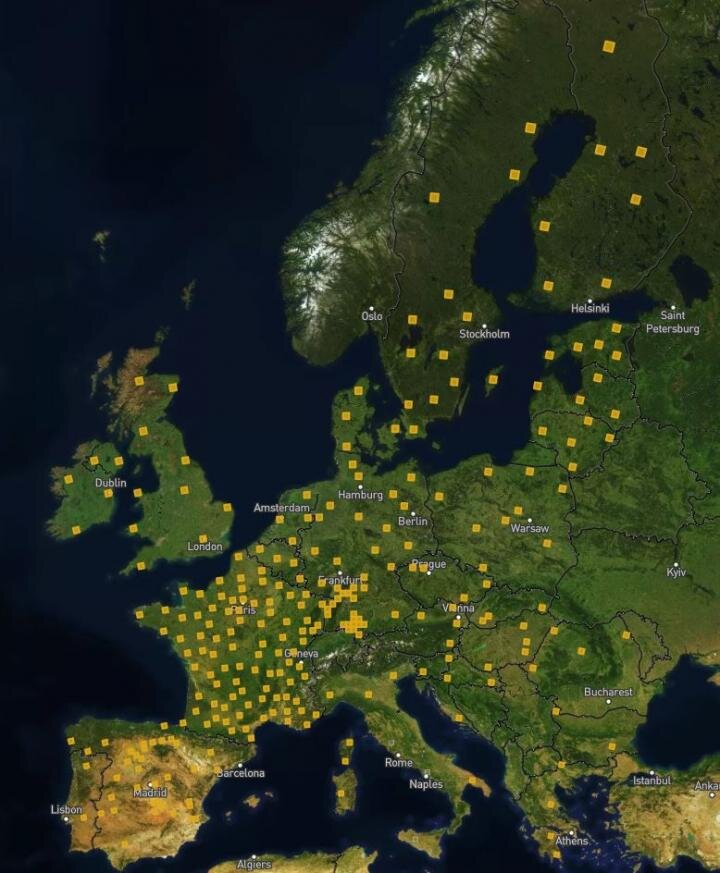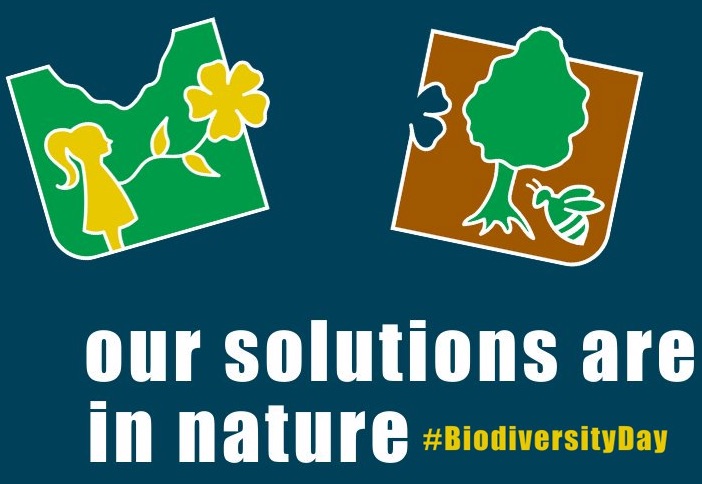
Wild fig tree rings offer a cheap method for tracking toxic atmospheric mercury, a byproduct of gold mining in the Global South, according to a study conducted in the Peruvian Amazon

Wild fig tree rings offer a cheap method for tracking toxic atmospheric mercury, a byproduct of gold mining in the Global South, according to a study conducted in the Peruvian Amazon

Plant ecologists compare temporal rhythms of early-flowering plants in different environments. They found that human land use can also significantly influence the pace of plant life cycles.

In 1966, US Army scientists drilled down through nearly a mile of ice in northwestern Greenland—and pulled up a fifteen-foot-long tube of dirt from the bottom. Then this frozen sediment was lost in a freezer for decades. It was accidentally rediscovered in 2017.

We are in the middle of a pandemic, but the experience is different for everyone. This was expressed beautifully in an original tweet by Damian Barr, later expanded by another author into a poem. “We are not all in the same boat. We are all in the same storm. Some are on super-yachts. Some have just the one oar.”

As plant scientists, we are all only too aware of the ‘plant blindness’ that pervades the world. The Global Plant Council aims to raise awareness about the importance of plant science (and its scientists) for society globally.

A webtool giving an overview of climate change in Europe and predicting subsequent developments was created as a joint collaboration between French, Spanish, German and Estonian researchers.

Undoubtedly, our solutions are embedded in nature but we need to find them, and more importantly learn to worship the nature. Raising awareness about respecting the nature’s bounty, conserving all biodiversity that it harborsand utilizing it for sustainable solutions is the key.

By W.J Davies and Jianbo Shen
Lancaster Environment centre, Lancaster University, Lancaster, LA1 4YQ. The UK and National Academy of Agriculture Green Development, Centre for Resources, Environment, and Food Security, China Agricultural University, Beijing, 100193, China.
Fourth post of our “Global Collaboration” series
In early 2019, the EAT-Lancet Commission on Healthy Diets from Sustainable Food Systems produced its first report. The Commission report addressed our need to effectively ‘feed a growing global population with a healthy diet while also defining the kinds of sustainable food systems that will minimise damage to our planet’. While it is clear that our current food and farming practices threaten both human and planetary health, the Commission concludes ‘that Global Food Systems can provide win-win diets to everyone by 2050 and beyond. However, this will require nothing less than a Great Food Transformation’
Despite a growing realisation of the magnitude of the challenges that are a part of such transformations, in most societies, progress is slow. Plants Science has much to contribute to enable better diet quality, increase crop productivity, enhance environmental sustainability and create new products and manufacturing processes (see example) but cannot alone bring about all of the required transformations.
For the required changes in government policies and in human behaviour, we must be able to convince people of both the nature and magnitude of the growing threats to human and planetary health as well convince all sectors of society to adopt as targets for the future, such as the UN Sustainability Goals. A range of actions is required from both organisations and individuals working at all scales.
Effective knowledge exchange (KE) mechanisms between scientists and food producers is recognised as being key to delivery of many changes in practice required within the framework defined above. Change is perhaps more easily achieved at the industrial farming scale where new genotypes and changes to farming systems are commonly produced and accepted. A wide range of publications means that practitioners can regularly see that these innovations can have significant effects on food availability and quality. However, most food in the world is still produced by smallholders and effective examples at scale of KE between science and this community are less common.
In China, there is an urgent need to address issues of food access and availability, food quality and safety and the environmental impact of agriculture in a society where diets are changing as the economy grows. As part of China’s successful green revolution over the last 50 years, enormous increases in food production have been achieved largely as a result of advances in both plant breeding and agronomy Very large increases in the usage of fertiliser, agrochemicals and particularly of water have increased productivity but all of this has been very damaging to the environment in many regions. Commonly, both quality and safety of food are significant issues in China due to both contamination with agrochemicals and as a result of food fraud.
Nevertheless some positive changes are underway in the food system with increased consumption of fruit and organic vegetables in Chinese diets but even here extra water use is often required and this is certainly the case also as a result of increasing consumption of meat in the diets of increasing numbers of people. Excess water consumption has reduced water tables in many regions of China (and other important food production regions). Reduction to dangerously low levels is leading to desertification in some regions with real threats to capacity for sustained production by farmers in these and other regions. Excess fertiliser use has resulted in many high profile pollution problems in surface waters which are valuable both for agriculture and for cultural tourism.

The introduction by scientists at China Agriculture University of ‘Science and Technology Backyards’ (STBs) is one very innovative approach to helping smallholders in China transform agriculture to respond to the challenge of greater ‘Ecological Civilization’, as set out in recent years by the Chinese Government. Using such an approach to exploit recent advances in plant and crop science is very much in tune with the agenda of EAT-Lancet Commission. In increasing numbers of communities across China, agricultural scientists living in villages among farmers to achieve yield and economic gains sustainably. The aims of this knowledge exchange programme are to advance participatory innovation and technology transfer and garner public and private support for these innovations. The approach has identified multifaceted yield-limiting factors involving agronomic, infrastructural, and socioeconomic conditions and interventions at the personal and community level are transforming peoples’ lives.
Due to past experiences of famine and political instability, China’s government has made grain production and food security a top priority for the nation. By the 2000s, after years of food shortage, China finally produced enough food annually to feed its enormous population. Now, China has set a new target of green growth in future grain production. This target involves high efficiency in resource use with reduced environmental risk. Novel developments in agronomy enable maintenance of a relatively high grain yield on a regional scale. To help deliver on these targets, China is also developing strong policy incentives for environmental protection and green growth in grain production. Going forward, it is planned that Chinese agriculture will continue to put into practice a vision of innovative, coordinated rural revitalization and green development. The science and technology backyard (STB) model could provide an effective approach to realize the green development of agriculture, as it aims to close yield gaps in China by empowering smallholder farmers through integrating efforts of researchers, farmers, the government, and agro-enterprises.
Success at scale in improving sustainable resource use and increasing grain production in China will enhance the country’s food security while decreasing poverty and the environmental footprint of food production, thereby contributing to the global goal of sustainable development. To meet new demands of Chinese agriculture in a new era, as well as for promoting further implementation of United Nations (UN) Sustainable Development Goals (SDGs), the National Academy of Agriculture Green Development and the International School of Agriculture Green Development were launched by China Agricultural University in July, 2018. A national strategy of Agricultural Green Development, issued by the central Chinese Government is likely to provide valuable understanding and new production practices, particularly for smallholders in other developing countries that are already facing or will soon face dietary and environmental challenges similar to those currently faced by China.
This article was republished from SciDev.Net.
Relocating coffee areas, along with forestation and forest conservation, to higher altitudes to cope with climate change could increase Ethiopia‘s coffee farming area fourfold, a study predicts.
The study, published in Nature last month (19 June), suggests that moving Ethiopian coffee fields to higher ground because of climate change could increase resilience by substantially increasing the country’s suitable production area.
Justin Moat, spatial analyst at the UK’s Royal Botanic Gardens Kew, and lead author of the study, says that currently coffee farming is mainly confined to altitudes between 1200 and 2200 metres.
“A critical factor in the suitability of coffee farming is the interaction between rainfall and temperature.”
Justin Moat
“In general, coffee’s niche will move uphill to keep to optimal temperature,“ he tells SciDev.Net. “Much work would be needed to achieve this if planning starts now.”
According to Moat, up to 60 per cent of the country‘s current production area could become unsuitable before the end of the century.
Ethiopia, he says, is the world’s 5th largest coffee producer. The crop provides a quarter of export earnings, and approximately 15 million Ethiopians engage in coffee farming and production.
The study‘s results were based on computer modelling and simulations. “We determined coffee-preferred climate (niche) using a huge amount of data collected on the ground, including historic observations, overlaid on climate maps,” explains Moat.
They projected this niche into the future using climate models and scenarios, which revealed that all the models were in general agreement. They then combined this with satellite imagery to come up with the present-day forest coffee area, and the area projected in the future.
Higher altitudes are forecast to become more suitable for coffee while lower altitudes are projected to become less suitable, according to the study.
“A critical factor in the suitability of coffee farming is the interaction between rainfall and temperature; higher temperatures could be tolerated if there was an increase in rainfall,” Moat notes.
He adds that regardless of interventions, one of the country‘s best known coffee-growing regions — Harar, in eastern Ethiopia — is likely to disappear before the end of the century.
Shem Wandiga, a professor of chemistry at the University of Nairobi’s Institute for Climate Change Adaptation, Kenya, says that although the study cannot predict with full certainty, it holds important messages for policymakers.
“Start planning to expand coffee growing areas to higher elevation, he suggests. “The expansion should be coupled with forestation of the areas.“
Researchers and policymakers should also map out the human, social and ecological conditions that may allow such expansion, according to Wandiga. Also, farmers should slowly substitute coffee with other plants that may bring income.
William Ndegwa, Kitui County director at the Kenya Meteorological Department, says the model used in the research is a powerful tool for linking climate variables with biological parameters.
“This is a very interesting [study] with deep insights into the characteristics of the impacts of climate change on crop production,” he notes.
This piece was produced by SciDev.Net’s Sub-Saharan Africa-English desk.
This article was originally published on SciDev.Net. Read the original article.
For Africa to end chronic hunger, governments must invest in sustainable water supplies.
The fields are bare under the scorching sun and temperatures rise with every passing week. Any crops the extreme temperatures haven’t destroyed, the insect pests have, and for many farmers, there is nothing they can do. Now, news about hunger across Africa makes mass media headlines daily.
Globally, hunger levels are at their highest. In fact, according to the Famine Early Warning Systems Network, over 70 million people across 45 countries will require food emergency assistance in 2017, with Africa being home to three of the four countries deemed to face a critical risk of famine: Nigeria, South Sudan, Sudan and Yemen. African governments, non-governmental organisations (NGOs) and humanitarian relief agencies, including the United Nations World Food Programme, continue to launch short-term solutions such as food relief supplies to avert the situation. Kenya, for example, is handing cash transfers and food relief to its affected citizens. The UN World Food Programme is also distributing food to drought-stricken Somalia. And in Zambia, the government is employing every tool including its military to combat insect pest infestation.
But why are we here? What happened? Why is there such a large drought?
Many African smallholder farmers depend on rain-fed agriculture, and because last year’s rains were inadequate, many farmers never harvested any crops.
Indeed, failed rains across parts of the Horn of Africa have led to the current drought that is affecting Somalia, south-eastern Ethiopia and northern and eastern Kenya.
Then, even in the countries where adequate rains fell, many of the farmers had to farm on depleted soils, and consequently, the yields were lower. Degraded soils and dependence on rain-fed agriculture coupled with planting the wrong crop varieties are some of the fundamental problems that lead to poor harvests and then to hunger. Worsening the situation is the unpredictable climate. Given these fundamental and basic issues that fuel the hunger cycle in Africa, it naturally makes sense to tackle them.
It is not rocket science. Farming goes hand-in-hand with water. There can be no farming without it. While this seems easy to reason, there are few organisations working to make sure that African farmers and citizens have access to permanent water sources. Access to water sources all year round would ensure that farmers can farm year in and year out.
African governments must, therefore, invest in ensuring that their citizens have access to water. Measures that can be implemented include drilling and rehabilitating boreholes, creating reservoirs and irrigation systems, constructing hand-pumps and implementing water harvesting schemes. Such measures would go a long way and ensure that countries continue to face the same problem both in the short and long term periods.
“If Africa wants to end the recurring droughts, hard decisions must be made.”
Esther Ngumbi, Auburn University in Alabama. United States
Of course it is understandable that it can be hard to choose long-term solutions such as ensuring that citizens have access to permanent water sources year round over investing in short-term solutions when there are people who need help now.
Acknowledging this dilemma, Mitiku Kassa, the Ethiopia’s commissioner for disaster risk management, is reported to have described how hard it was to direct even a fifth of his budget towards well drilling. But such decisions must be made. The Ethiopian government still made that tough decision and sunk hundreds of bore wells throughout the country.
There is a great need to ramp up water harvesting and conservation efforts across the African continent. African governments and other stakeholders need to increase investment in multiple water-storing techniques. Such techniques include rain and flood water harvesting and the construction of water storage ponds and dams. But there should be no need to reinvent the wheel.
African countries can learn from other countries. Countries in the developed world have sustained their agriculture efforts by either drilling water wells to ensure they have access to the water they need for farming or by investing in rain and flood water harvesting. In California, for example, there have been a rise in the number of wells being drilled by farmers who use well water for farming. In 2016 alone, farmers in the San Joaquin Valley dug about 2,500 wells, a number that was five times the annual average reported in the last 30 years.
Countries such as Bangladesh, China, India, Myanmar, Sri Lanka and Thailand have made progress and are working on pilot projects that capture, harvest and store flood water. Stored water is then available for use by communities when they need it the most. Harvesting and storing water and making it available for agriculture, especially during the dry seasons, will allow citizens and smallholder farmers to farm throughout the year. These would further improve the resilience of farmers to the unpredictability of climate change.
If Africa wants to end the recurring droughts, hard decisions must be made. By addressing the fundamental and basic issues of long-term availability of water for agriculture, African countries can once and for all end this never-ending cycle of hunger.
Esther Ngumbi is a postdoctoral researcher at the Department of Entomology and Plant Pathology at Auburn University in Alabama, United States. She serves as a 2015 Clinton Global University (CGI U) Mentor for Agriculture and is a 2015 New Voices Fellow at the Aspen Institute.
This piece was produced by SciDev.Net’s Sub-Saharan Africa English desk.
Humphrey Nkonde Dramatic threat to maize harvest (Development and Cooperation, 6 March 2017)
Mohammed Yusuf UN: 17 Million People Face Hunger East Africa (Voice of America, 8 March 2017)
Karen McVeigh Somalia famine fears prompt UN call for ‘immediate and massive’ reaction (the Guardian, 3 February 2017)
Emergency food assistance needs unprecedented as Famine threatens four countries (Famine Early Warning Systems Network, 25 January 2017)
Kazungu Samuel Kenya: Red Cross Comes to the Aid of Drought-Hit Kilifi Residents (allAfrica, 2017)
Army worms invades Zambia’s farms (Azania Post, 6 February 2017)
Lesson learned? An urgent call for action in response to the drought crisis in the horn of Africa (Inter Agency Working Group on Disaster Preparedness for East and Central Africa, 2017)
Amanda Little The Ethiopian Guide to Famine Prevention (Bloomberg Business Week, 22 December 2016)
Central Valley farmers drill more, deeper wells as drought limits loom (CBS SF Bay Area, 15 September 2016)
Underground taming floods for irrigation(International Water Management Institute, 2017)
This article was originally published on SciDev.Net. Read the original article.